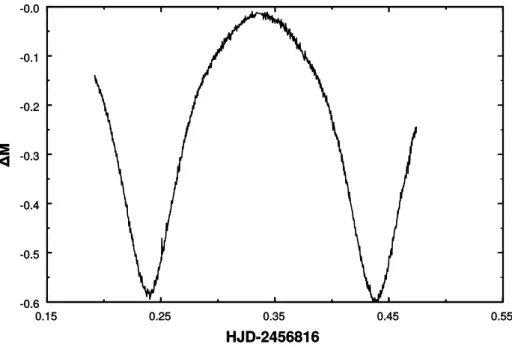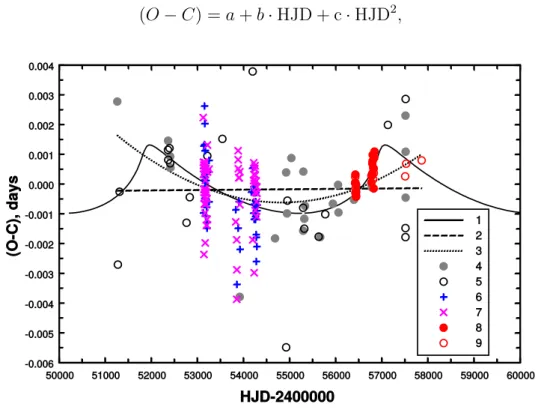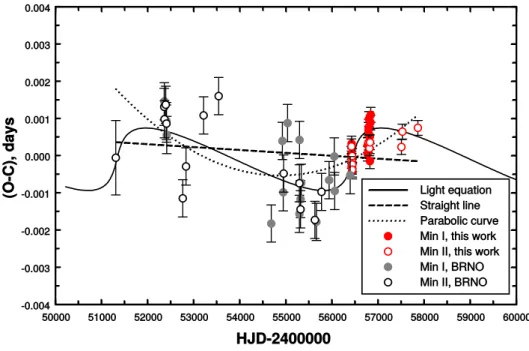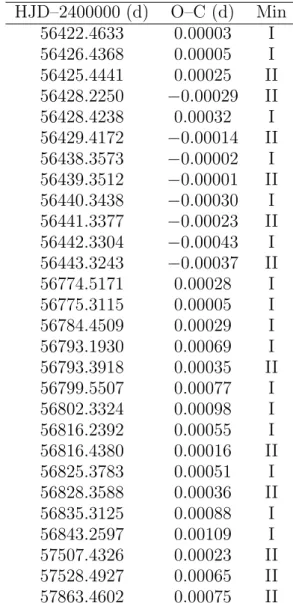COMMISSIONS G1 AND G4 OF THE IAU INFORMATION BULLETIN ON VARIABLE STARS
Volume 63 Number 6235 DOI: 10.22444/IBVS.6235
Konkoly Observatory Budapest
23 January 2018 HU ISSN 0374 – 0676
TIMING OF AR CrB ECLIPSES
KOZYREVA, V. S.1; IRSMAMBETOVA, T. R.1; IBRAHIMOV, M. A.2; KRUSHEVSKA, V. N.3; KUZNYETSOVA, YU. G.3; KHALIKOVA, A. V.4; PARMONOV, O. U.4; KARIMOV, R. G.4; BOGO- MAZOV, A. I.1, SATOVSKII, B. L.5; TUTUKOV, A. V.2
1 M. V. Lomonosov Moscow State University, P. K. Sternberg Astronomical Institute, 13, Universitetskij prospect, Moscow, 119991, Russia
2 Institute of Astronomy, Russian Academy of Sciences, 48 Pyatnitskaya st., 119017, Moscow, Russia
3 Main Astronomical Observatory, National Academy of Sciences of Ukraine, 27, Akademika Zabolotnoho ulitsa, Kyiv, 03143, Ukraine
4 Ulugh Beg Astronomical Institute, Uzbek Academy of Sciences, 33, Astronomicheskaya ulitsa, Tashkent, 100052, Uzbekistan
5 AstroTel Ltd., 1A, Nizhegorodskaya ulitsa, Moscow, 109147, Russia
Abstract
AR CrB is a short-period low-mass eclipsing binary. We conducted photometric observations of the system in 2013, 2014, 2016, 2017, and obtained times of its light curves minima. The timing of eclipses (our times of minima combined with data from the literature) shows that the orbital period of AR CrB could possess periodical variations that can be explained by the gravitational influence of a third companion in a highly eccentric orbit around the central binary.
AR CrB is a short-period low-mass eclipsing binary star, its orbital period is 0.397352 days according to the General Catalogue of Variable Stars (Samus et al., 2017), its type of variability is EW. We conducted a timing of its eclipses using times of minima obtained from our observations (see Table 1) combined with times of minima from the B.R.N.O.
database1, we also calculated (see Tables 2 and 3) and used times of minima from Super- WASP light curves2,3 (Butters et al., 2010, Paunzen et al., 2014). Our calculations show that the AR CrB orbital period can possess periodical variations that can be explained by the gravitational influence of a third companion in a highly eccentric orbit around the central binary.
The AR CrB eclipsing binary was observed from two observatories: (1) Maidanak observatory of Ulugh Beg Astronomical Institute of Uzbek Academy of Sciences, 60 cm Zeiss telescope (in 2013, 2014), (2) South Station of M. V. Lomonosov Moscow State University, Nauchnij, Crimea, 60 cm Zeiss telescope (2014, 2016, 2017). We used BesselR (Maidanak) and CousinsR(Crimea) filters, and following CCD cameras: FLI PL 1K×1K (Maidanak), Apogee Ap47p (Crimea, 2014), FLI PL 4022 (Crimea, 2016), Apogee Aspen (Crimea, 2017). Dates of the observations are: 09, 10, 12, 13, 15, 16, 25, 26, 27, 28, 29, 30 May 2013, 15, 24 May, 01, 07, 19, 26, June, 04 July 2014 (Maidanak), 26, 27, April, 06, 21 May 2014, 28, April, 19 May 2016, 19, 30 April 2017 (Crimea). As comparison star
Figure 1. A sample light curve of AR CrB, BesselRfilter.
we chose IRAS 15569+2754. Our light curves are available online as supplementary files to the paper (Tables 4–29).
For data processing we used the aperture photometry method with the program C- Munipack4 for data from the Maidanak observatory and Maxim DL for data from Crimea.
For the SuperWASP data we used the “Mag2” column (this column had 1-4 points with the same HJD, so we averaged their magnitude with the same HJD), only symmetric light curves around minima were used to find times of minima. To estimate parameters of the binary a computer code by Kozyreva & Zakharov (2001) was used. Due to the code features we cannot estimate precisely all geometrical quantities of an EW type system, so we present here only several of them: the orbital eccentricity of the central binary is e = 0.0014±0.0005 (the existence of such eccentricity also can be confirmed by the differences in the initial epochs of primary and secondary minima of 0.0003 days), the inclination of this orbit is i= 82.0±4◦.
We obtained following ephemerides:
Min I = T1 + Porb×E, (1)
Min II = T2+ Porb×(E + 0.5), (2)
whereT1 = HJD 2452365.5031±0.003 andT2 = HJD 2452365.5032±0.003 are the initial epochs for primary and secondary minima respectively, E is the number of orbital cycles since the initial epoch, Porb = 0.397351625±0.000000050 d is the orbital period of AR CrB. We calculated O–C values for times of minima and fitted them by a light equation and by a parabolic curve. We estimate the significance of our results using a statistical method by Stellingwerf (1978) and calculate the value
1http://var2.astro.cz/ocgate/?lang=en
2https://exoplanetarchive.ipac.caltech.edu/docs/SuperWASPMission.html
3http://wasp.cerit-sc.cz/
4http://c-munipack.sourceforge.net
IBVS6235 3
θ = σ2
σ02, (3)
whereσ0 is the standard deviation that corresponds to the values of O–C calculated using Equations (1) and (2), σ is the standard deviation that is corrected with the theoretical curve. The smaller value ofθ corresponds to the better coincidence between observational data and the theoretical fit.
The results of our calculations are presented in Figures 2 and 3. For the parabolic fit we used an expression
(O−C) =a+b·HJD + c·HJD2, (4)
Figure 2. O–C diagram for times of minima of AR CrB from the literature (B.R.N.O. database), from our observations (Table 1), and from the SuperWASP project (Tables 2 and 3, available online). The indications in the Figure are following: (1) is the light equation curve, (2) is the straight line, (3) is the parabolic curve, (4) Min I, B.R.N.O. database, (5) Min II, B.R.N.O. database, (6) Min I, SuperWASP,
(7) Min II, SuperWASP, (8) Min I, this work, (9) Min II, this work.
see below for values of parameters in this formula. For the light equation we estimated following parameters: its amplitude A3, the orbital period of the third companion P3
days, its orbital eccentricitye, its ascending node longitudeω3. The time of the periastron passage TP for the new body is:
TP =T3+E3×P3, (5)
where T3 is the initial epoch, E3 is the number of the third body orbital cycles since its initial epoch.
For Figure 2 we took into account all available times of minima (from the B.R.N.O.
database, SuperWASP times of minima, and our times of minima). The linear curve is parallel to the x axis. Values of parameters in Equation (4) are: a = 0.53089, b =
Figure 3. The same as Figure 2 for the best observational points.
−0.000019,c= 1.78·10−10. The orbital period change in this case corresponds to 8.2·10−8 days per year. For this (parabolic) curve: σ0 = 0.00120, σ = 0.00114, θ = 0.90. For the light equation: A3 = 0.0014 ±0.0001, P3 = 5108±50 days, e = 0.8, ω3 = 44◦, T3 = HJD2455321±150, σ0 = 0.00120, σ = 0.00110, θ = 0.84. For the linear approximation σ =σ0 and θ = 1.
For Figure 3 we used only “good” points, i.e., where the deviation is less than 2.5σ0. For the linear approximation σ = 0.00083, σ0 = 0.00084, and θ = 0.98. Values of parameters in Equation (4) are: a = 0.55035, b = −0.000020, c = 1.88·10−10. The orbital period change in this case corresponds to 8.6· 10−8 days per year. For the parabolic curve:
σ0 = 0.00084, σ = 0.00071, θ = 0.71. For the light equation: A3 = 0.0014 ±0.0001, P3 = 5360 ± 50 days, e = 0.7, ω3 = 26◦, T3 = HJD2455544 ±150, σ0 = 0.00084, σ = 0.00061, θ= 0.53.
In both cases (all times of minima and “good” times of minima) the hypothesis of the third companion is more preferable than linear or parabolic curves. So, the possible presence of a third body in AR CrB can be a common feature of binaries. The observed initial distribution of components of binary stars over separations was described as follows (Equation (22), Masevich & Tutukov, 1988, page 110):
dN = 0.2dlog(a/R⊙), 1≤log(a/R⊙)≤6, (6) To estimate the possible multiplicity we can take this function as a probability to find a new companion in a multiple system. Due to selection effects one can miss of compo- nent of very close binaries or binaries with faint companions, therefore binaries can be triples/multiples.
There are no spectral data for AR CrB, therefore the masses of components are un- known, so the lower limit of the suggested third body mass can be estimated to be several percent of total mass of the system according to its mass function, its value is ≈0.05.
Less favourable explanations (according to θ values) of the orbital period change (in case of the parabolic curve) in AR CrB are the mass transfer between components (that
IBVS6235 5
Table 1: Times of minima of AR CrB obtained from our observations.
HJD–2400000 (d) O–C (d) Min 56422.4633 0.00003 I 56426.4368 0.00005 I 56425.4441 0.00025 II 56428.2250 −0.00029 II 56428.4238 0.00032 I 56429.4172 −0.00014 II 56438.3573 −0.00002 I 56439.3512 −0.00001 II 56440.3438 −0.00030 I 56441.3377 −0.00023 II 56442.3304 −0.00043 I 56443.3243 −0.00037 II 56774.5171 0.00028 I 56775.3115 0.00005 I 56784.4509 0.00029 I 56793.1930 0.00069 I 56793.3918 0.00035 II 56799.5507 0.00077 I 56802.3324 0.00098 I 56816.2392 0.00055 I 56816.4380 0.00016 II 56825.3783 0.00051 I 56828.3588 0.00036 II 56835.3125 0.00088 I 56843.2597 0.00109 I 57507.4326 0.00023 II 57528.4927 0.00065 II 57863.4602 0.00075 II
can also cause a long period variation of the orbital period, Liu, Quian and Xiong, 2018) and the Applegate’s (1992) magnetic mechanism that changes the quadrupole gravita- tional momentum of one of the components (or both of them).
References:
Applegate J. H., 1992, ApJ, 385, 621 DOI
Butters O. W., West R. G., Anderson D. R., et al., 2010,A&A, 520, L10 DOI Kozyreva V. S., Zakharov A. I., 2001, Astronomy Letters, 27, 712 DOI
Liu L., Qian S.-B., Xiong X., 2018,MNRAS,474, 5199 DOI
Masevich A. G., Tutukov A. V., 1988, Evolution of Stars: Theory and Observations, Moscow, Nauka (in Russian)
Paunzen E., Kuba M., West R. G., Zejda M., 2014, IBVS, No. 6090
Samus N. N., Kazarovets E. V., Durlevich O. V., Kireeva N. N., Pastukhova E. N., 2017, Astronomy Reports, 61, 80 DOI
Stellingwerf R. F., 1978, ApJ, 224, 953 DOI



